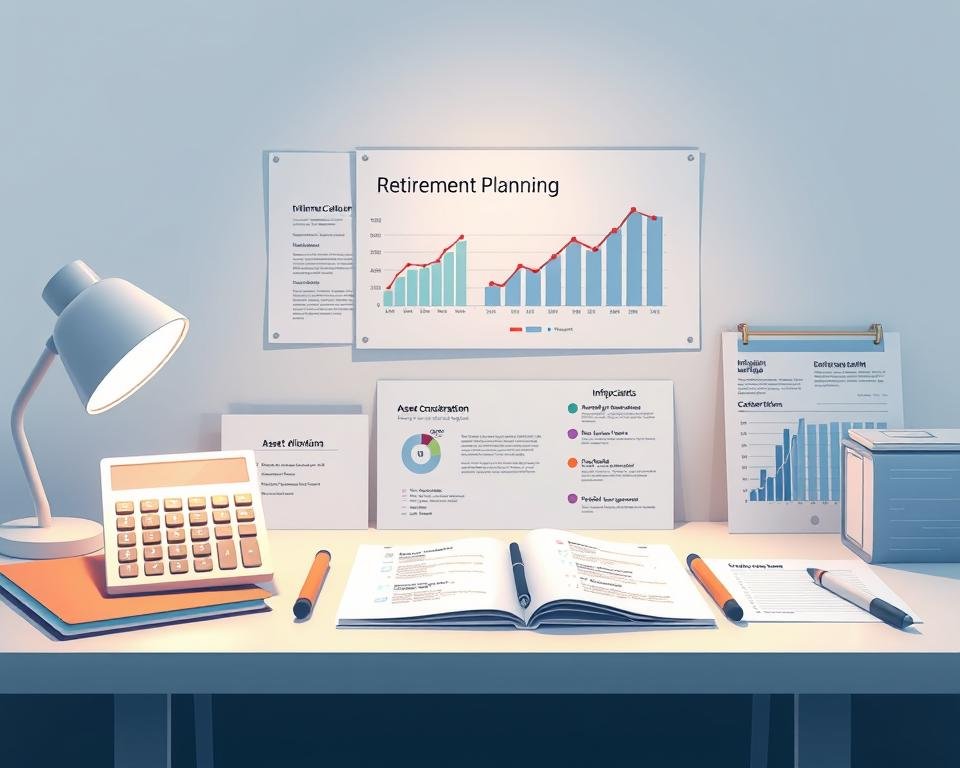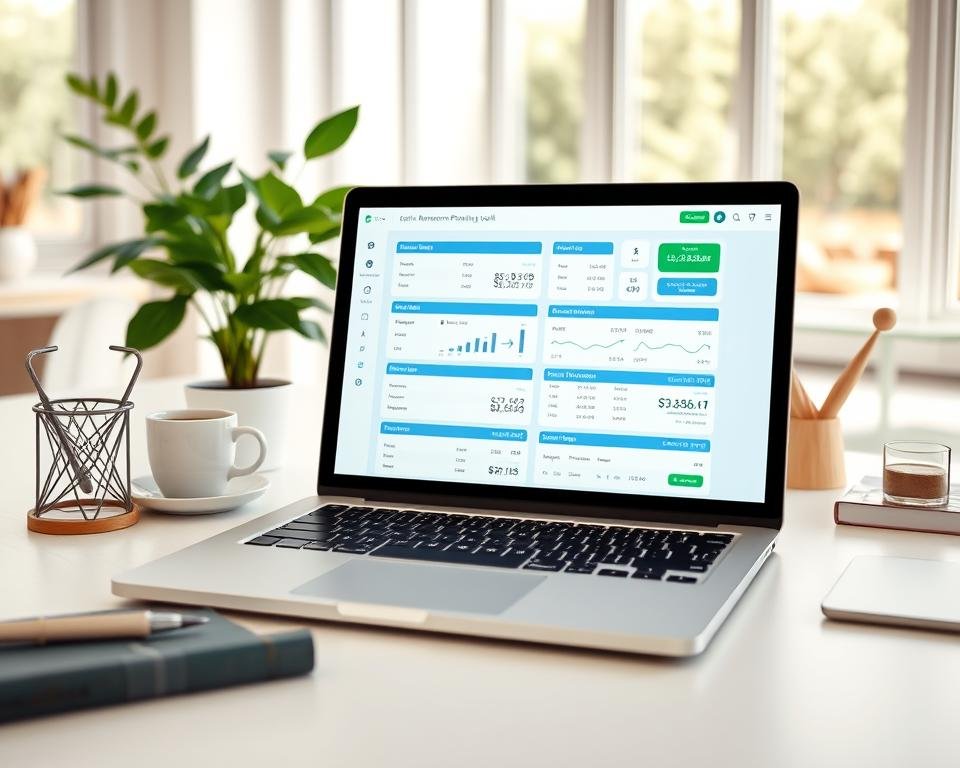Did you know that over 60% of retirees find themselves surprised by how their savings and pensions are impacted by taxes and benefits? That’s why having a reliable retirement planning tool is crucial. Studies show that people who plan for retirement tend to do better financially, making it even more important to start early.
Before you use any online retirement planners or software, it’s important to gather all necessary documents. Make sure you have your Social Security information, pension statements, and records of any savings accounts like RRSPs or 401(k)s. This helps ensure the data you input is accurate.
Public calculators, like the Canadian Retirement Income Calculator and tools from banks, don’t need your personal details. But they do remind you that the results are just examples. Commercial options work similarly by asking for information like your age, when you want to retire, how much you earn, and what you expect to make on your investments. The details can greatly affect the outcome, so think of these tools as guiding maps rather than definite paths.
When exploring different tools, pay close attention to how they handle inflation, taxes, and returns after you retire. If something seems too straightforward, try changing your inputs or seek advice from an expert for tricky issues. Complications like pension indexing, reduction in benefits, or costs for long-term care need careful consideration. Visualization tools can also help balance these priorities and plan for the future effectively.
Key Takeaways
- Gather pension statements, Social Security/CPP info, and retirement account balances before using a retirement planning tool.
- Online retirement planners and retirement planning software provide estimates, not guarantees.
- Assumptions for returns, inflation, and taxes have large effects on projected retirement income.
- Use multiple tools to compare scenarios and spot input sensitivity.
- Consult a financial professional when you face pensions, complex tax situations, or estate concerns.
- For a quick Social Security calc reference, explore resources like retirement planning calculators.
Why use retirement planning calculators and financial tools
You want to know about your future money, how much you need to save, and when. Retirement calculators and financial tools change guesses into solid numbers. They let you see different futures, check if your plans work, and find problems early. Then, you can change how much you save or your plans.
Benefits of using calculators for retirement decisions
Calculators make unclear decisions clearer. They help you guess future income, look at Social Security or CPP, and include job pensions.
Websites from places like the Social Security Administration give you calculators and budget aids. This mix helps you see how your retirement money fits with paying off debt and house costs.
How tools improve accuracy versus rough estimates
Quick, basic math misses out on timing, taxes, and rising costs. Retirement software looks at different ages to retire, returns, and taxes for more accurate predictions.
Professional planners let you try out many future scenarios and see the money after taxes. This detail cuts down surprises and helps with smart choices between saving more and how you’ll live when retired.
When to consult a financial professional after using a tool
Start with tools to spot problems and decide what’s most important. If you see you might not have enough, or the rules seem complicated, talk to a certified financial planner or tax advisor.
Experts can check your calculations, help with complex guesses, and make plans for taking out money. See tools as the initial step towards detailed, personal advice when you need it.
Key inputs most retirement planning tools require
Before using any retirement planning tool, it’s crucial to have accurate numbers ready. Right inputs mean reliable outcomes. Wrong info about your age, earnings, or funds can derail your plan. The right tool directs you, allowing scenario comparisons confidently.

Current age and age at retirement — why timing matters
How old you are now and when you plan to retire affects your savings duration and needs. Retiring later reduces the time you’ll need to pull from savings and might increase benefits like Social Security. Inputting exact ages helps create an accurate saving and spending schedule. Additionally, the later you wait to apply for Social Security benefits, the higher your payments will be, which can significantly impact your retirement income.
Gross annual income and percent of income to save
Write down your pre-tax earnings and how much you aim to save regularly. Your annual income determines your tax rates and how much you can put into 401(k)s and IRAs. Retirement tools show how saving more or less impacts your financial future.
Current retirement savings and company pension information
Collect your 401(k), IRA, and pension statements. For defined benefit plans, add your pension amount and starting choices. Accurate account and pension info aids in forecasting income replacements and spotting today’s savings gaps.
Expected rates of return before and during retirement
Retirement tools ask for your expected returns and inflation rates because even small changes can significantly impact your future. Use different rates for the saving and spending phases if your investment approach will change. Good planning tools allow exploring various return scenarios to see a range of possible outcomes.
- Include spouse data when relevant to model joint benefits and survivor options.
- Record contribution frequencies, future lump sums, and outstanding debts that affect cash flow.
- Note expected CPP/Social Security timing and any annuities or foreign pensions you expect to receive.
Types of retirement calculators you should know about
Choosing the right calculator can make numbers easier to understand. You might start simple and get more detailed as needed. Here’s a look at common types and their importance.
Basic retirement savings calculators
These tools help you see future savings by entering age, savings, and how much you’re adding. They’re great for a quick look at your savings progress. Use them to check your savings quickly, then explore more advanced tools.
Income and cash-flow calculators (including RRIF withdrawal estimates)
Income calculators show monthly or annual income from your savings. They consider things like 401(k) balances and how you plan to take money out. Changing how much you withdraw shows different outcomes for fund longevity and immediate income needs.
Defined benefit pension estimators and CPP/OAS timing tools
These calculators help with government benefits like CPP or Social Security. They look at how different start times affect your income over a lifetime. Pension estimators compare regular payments to taking all your money out at once or in stages.
Tax-aware retirement tax planning software and withdrawal models
Tax-focused tools consider the tax impact of taking money from various accounts. They aim to lower taxes and keep you from jumping into a higher tax bracket. If you’re worried about taxes, this software tests different withdrawal strategies. It’s also worth noting that after age 70, your Social Security benefit amount no longer increases, so planning withdrawals accordingly is essential.
Some sites offer cash-flow tools with extras like mortgage calculators. This helps you see how debts might impact your retirement. Other software offers risk analysis to discuss with experts.
If you’re figuring out how to draw your money smartly, some software can guide you. Always review these findings with a pro for tax or pension advice.
How to choose the best retirement planning tool

Picking the right tools for retirement planning means matching features with your finances. Look for software that supports pensions, RRSP/401(k) accounts, IRAs, and TFSAs. This ensures your projections include all income sources. If you get a defined-benefit pension, check if you can enter its amount, start date, and survival options.
Match features to your situation
First, decide if you need a simple calculator or more comprehensive software. If you deal with employer pensions and various accounts, pick a tool tailored to those needs. Tools vary, with some offering detailed modeling of pension plans, while others might miss some specifics.
Check assumptions: returns, inflation, timing
Look over the default assumptions for returns, inflation, salary growth, and fees. Adjust the inflation rate to a realistic figure like 2%. Some tools reflect the same fees you’d find with services like Wealthsimple, showing both management fees and fund costs.
Privacy and data handling
Privacy measures differ widely. Government calculators often keep your info private, while others might store your data for syncing purposes. Make sure to check if a tool operates in your browser, stores data securely, or can be used anonymously.
Usability: online planners vs. downloadable software
Online planners offer easy access and auto-updates. They’re great for fast checks and basic planning. Downloadable software, though more complex, provides in-depth analysis and requires some effort to learn.
Explore different options and export reports if you can. Choose a tool that offers the right mix of ease, privacy, and detailed modeling. To start, try an interactive tool like Wealthsimple’s retirement calculator. Then, compare its results with advice from pension planning articles.
Top features to look for in retirement plan software
When picking retirement planning tools, focus on features that solve real-life issues. Choose solutions for testing various scenarios, checking taxes, and creating reports. These reports should be easy to share with a financial expert.
Scenario planning and “what if” analysis
Good retirement software will have Monte Carlo simulations and other tools. These let you see many possible outcomes for market changes and how long your money might last. You should be able to model big expenses, changes in spending, and when to start pensions or Social Security.
This scenario planning lets you weigh the pros and cons of early pensions against saving more now.
Tax planning and withdrawal sequencing
Choosing the right sequence for withdrawals is key to avoid tax surprises. Pick software that tests pulling money from different accounts, such as 401(k)s and Roth IRAs. This helps you see how taxes might vary over the years.
Your chosen tool should also let you explore different tax statuses and potential tax changes in the future.
Income strategy software tools for sustainable withdrawals
Tools for income strategies often provide calculators for withdrawals, which do more than the basic 4% rule. Look for features that calculate safe withdrawal rates, factoring in market trends and inflation. These will help you plan your cash flow while trying to keep your funds lasting longer.
Exportable reports and advisor collaboration options
Opt for tools that generate reports and statements easy to share with advisors at Vanguard, Fidelity, or independently. Having clear PDFs and CSVs helps with collaborations and speeds up reviewing decisions.
To see practical examples and tools for comparing debt, savings, and retirement goals, visit financial goal guides. For a comprehensive platform with account tracking and scenario testing, check out WealthTrace. It showcases projections, fees, and more.
Practical walkthrough: using an online retirement planner
Start by gathering your records for easy and accurate data entry. Collect info like CPP/QPP, Social Security statements, and details about pensions. This includes RRSP or 401(k) statements, TFSA or IRA balances, annuity contracts, and any foreign pension papers.

Then, pick your favorite retirement planning tool online. Create your profile. Include your location, how old you are, and when you want to retire. Put in your yearly income before taxes and any expected changes to it.
Input your current savings and how much you regularly contribute. Add details about your employer’s pension and any matching they do. Make sure to include regular contributions to both registered and non-registered accounts. If you’re using budget software, merge those details to align with your contribution plans and expected costs. For advice on 401(k) details, check a guide like Principal 401(k) plan.
Make careful guesses for investment growth rates and inflation. Choose cautious return rates for each account and a moderate inflation figure. Retirement planning software often lets you set different growth guesses for stocks, bonds, and cash.
Accurately add any one-time events and info about employer pensions. Put in details like lump-sum pensions, expected inheritances, and any big sales or withdrawals. If you have a pension that pays a set amount, enter the exact number or use the tool’s estimator.
Try different scenarios and look at the results. Note your income replacement rate, expected income after taxes, and how long your money might last. Adjust settings in the tool to explore how varying return rates and retirement ages can change your results.
If you find any gaps, the planner will suggest ways to fix it. This might mean saving more, retiring later, or changing how you withdraw money. See these suggestions as a guide, not a promise. For complicated situations, think about talking to a financial advisor.
Common pitfalls and limitations of retirement calculators
Using a retirement planning tool gives you quick estimates. But they may seem more exact than they are. Think of these numbers as a starting point, not the final word.
Overreliance on single-rate return assumptions
Most calculators use one yearly return rate. This approach is simple but overlooks market ups and downs. Relying on one rate might miss how bad markets or high inflation affect you.
To make your planning stronger, test different return rates. Look for calculators that offer complex outcomes like those from Monte Carlo simulations. This helps prepare you for unexpected turns.
Ignoring tax changes, benefit clawbacks, and program eligibility
Tools like those from the Social Security Administration remind users their estimates are just guesses. They often don’t foresee tax law shifts or reductions in benefits.
Many retirement tools overlook how your mortgage, taxes, and program rules interact. Make sure you’re up-to-date on Social Security and Medicare’s rules as you plan.
Underestimating healthcare, long-term care, and longevity risk
Costs for healthcare and long-term care can quickly drain your funds. Calculators may not fully cover these costs or assume too little. This is risky if you outlive your savings.
Add extra cushions or estimates for long-term care costs. Choose software that allows you to test various health expenses and life span changes.
Both commercial and consumer retirement tools stress that your results are only as good as the information you provide. It’s up to you to verify your data and adjust it when your life changes.
For better planning, mix and match different tools. Compare what you get from government calculators, consumer websites, and professional retirement software.
New retirement calculators and emerging tools to watch
Retirement planning is changing. Financial firms and apps are updating their methods. They’re focusing on interactive tools over traditional spreadsheets to help you see how your savings might grow or decline.

New tools combine powerful tech with easy-to-use designs. They let you see your financial future by linking real account data and using advanced models. This way, you understand the risks and possible shortfalls better.
- Interactive scenario engines — Tools like Monte Carlo simulations show different outcomes, not just one prediction. Many modern retirement calculators include these, letting you test various scenarios to see how changes might affect your investments.
- Account integration — This feature links your 401(k), IRAs, and banks to the tool. It updates your financial forecast as your balance changes, reacting to how you save, invest, or spend in real-time.
- Mobile and robo features — Today, mobile apps offer the same functions as desktop versions. Robo-advisors give automated advice and help manage your savings according to your retirement goals, all from your smartphone.
Choosing the right retirement software? Make sure it clearly explains its assumptions and disclosures. Understanding how it projects outcomes, accounts for taxes, and plans for benefits can help you trust its forecasts.
Now, many planners let you test situations like selling a house, losing a job, or getting a pension offer. These ready-made scenarios can streamline your planning process and show how big events might affect your finances.
Don’t settle on the first tool you try. Test several, using the same information, to see their different assumptions and how they handle risks. This approach helps you build a stronger plan and makes it easier to talk about your options with an advisor.
Comparing software for retirement planning: DIY vs. advisor-grade
Choosing the right tool depends on your needs. For simple needs, free tools from the government or banks work well. They offer quick estimates privately. This way, you can explore various savings goals and timings without extra cost.
Features and price points for consumer retirement planning tools
Apps by banks and fintech companies combine different functions. They include budgeting, mortgages, and retirement planning. These apps have easy visuals, link to your accounts automatically, and make goal-setting straightforward. They range from free to having a small monthly fee for more features.
These tools are user-friendly and good for basic planning like income replacement and withdrawals. However, they don’t often offer complex tax strategy or in-depth pension analysis.
When to upgrade to retirement plan software used by advisors
Consider advisor-grade software for complex finances, like multiple accounts and pensions. These platforms offer detailed simulations. They help you adjust for risk over the long term.
Professional tools help advisors plan for specific tax situations and withdrawal strategies. If you need detailed forecasts, paying for advisor-grade software is a good idea.
How to evaluate security, updates, and vendor support
Before uploading personal info, check the security features of the vendor. Look for encryption and two-factor authentication. Make sure the software only keeps necessary data or uses general information.
Find out how often the software updates for tax and benefit changes. Reliable vendors update regularly and keep you informed. Good support should include training and the ability to share reports with your advisor.
Consider cost, features, and privacy in your choice. Simple tools are great for starting. But, advisor-grade software may be better as your needs grow more complex.
retirement planning tool
A dedicated retirement planning tool makes it easy for you. You input your financial information such as income and accounts. Then, it shows you what your future might look like and spots any gaps in your plan.
How a dedicated retirement planning tool guides your inputs and outputs
Using a retirement planning tool involves simple steps. You’ll answer questions about your savings, any pensions from work, and when you plan to retire.
This tool connects with budget planners and goal trackers to make your plans real. Companies like Vanguard and Fidelity let you see how different pieces fit together in your financial plan.
Examples of inputs used (age, CPP/OAS timing, pension amounts)
You’ll enter things like your age, when you hope to retire, and how much you have in retirement accounts. You add info about any pensions from work and when you’ll get public benefits.
Canadians will make choices about CPP or QPP and OAS based on where they’ve lived. Americans deal with Social Security decisions in a similar way. You’ll also guess at future earnings, big money events, and how risk-averse you are.
Interpreting tool output: recommended savings rate, withdrawal strategy, and contingency steps
The tool suggests how much to save, projects your retirement income, and offers ideas for drawing your savings. It gives you a plan to fill in any gaps in your income.
There are advanced tools for tax planning and deciding the best order to use your savings. They help you prepare for changes in the market, tax alterations, and the risk of outliving your money.
- Projected income and how long savings may last
- Suggested contribution increases or timeline changes
- Alerts for likely shortfalls and next action items
Conclusion
Start by using a government calculator to get official estimates for your CPP, OAS, pensions, and registered accounts. These tools are reliable because they use your real benefit data. They also remind you that their results are examples, not a replacement for professional advice. Additionally, interactive worksheets from the Department of Labor can help manage finances and begin a savings plan.
Then, look at the bigger picture with other financial planners. Budget tools, mortgage calculators, and goal trackers show how retirement fits with your daily finances. Tools from companies offer extra by looking at risks, when you add money, big payments, and combining accounts. This helps you find missing pieces and try out different situations.
No retirement planning tool or software has it all. Always double-check their guesses about taxes, returns, and inflation. Use what you find to ask an advisor the right questions. If you need help deciding when to take out money, want to see many outcomes, or share plans, look at software made for advisors.
While using a retirement planning tool can provide valuable insights into your current plan and help estimate your future benefit amount, it’s important to remember that investing involves risk and you can lose money. Considering other factors such as withdrawal options, assets, and tax implications is essential for creating a sustainable income strategy.
No single tool can guarantee perfect accuracy, so consulting a tax advisor and regularly reviewing your retirement account will help you stay on track toward your retirement goals. By combining these approaches, you can better manage your retirement savings and make informed decisions for a secure financial future.
For a list of good calculators and to compare them, check out this guide on the best retirement calculators from Boldin. It can help you choose the right tools for your retirement plans.
